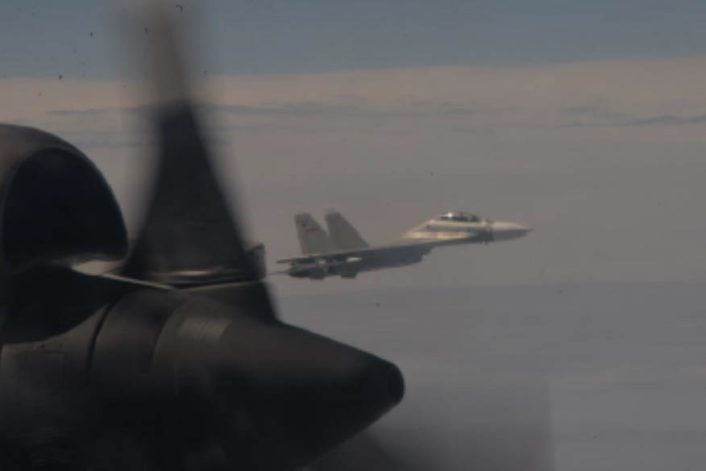The last EP-3Es may not be retired until March 2025, meanwhile, the planned homecoming ceremony for VQ-1 crews has been delayed due to Navy Operations.
A homecoming ceremony planned for the return of two U.S. Navy EP-3E electronic reconnaissance aircraft and their crews has been postponed due to ongoing operational commitments, likely related to escalating crisis in the Middle East, Seapower Magazine reported. The crews, part of Fleet Air Reconnaissance Squadron One (VQ-1), were scheduled to return to their home base at Naval Air Station (NAS) Whidbey Island, Washington. The ceremony was meant to commemorate the final operational deployments of the squadron and the venerable EP-3E, marking the end of an era for the Navy’s manned reconnaissance aircraft.
The delay was announced on the official Facebook account of VQ-1, known as the “World Watchers,” which has been the primary operator of the EP-3E since its inception. This comes after an earlier directive that VQ-1 was to cease operations by September 30, 2024, with deactivation scheduled for March 31, 2025. However, continued operational needs initially pushed the cessation date to October 8, 2024, and now have further postponed the squadron’s return, with no new date confirmed.
According to an Oct. 8 statement to Seapower from the Navy’s maritime patrol reconnaissance program office, the last EP-3Es may not be retired until March 2025.
Interestingly, as we write this story, an EP-3E is tracking online as it operates off Lebanon.
🇺🇸Lockheed EP-3E Aries II Orion pic.twitter.com/iXxmLhOhBi
— 360°Radar (@wipljw) October 11, 2024
The EP-3E
The EP-3E Aries II is a signals intelligence platform that has served for decades, gathering intelligence on foreign communications, electronic emissions, and troop movements.
The type first came into prominence in the late 1960s and has been continuously upgraded over the years to keep up with advancing technology. The aircraft was upgraded from being purely a signals intelligence (SIGINT) aircraft to a Multi-Intelligence platform, making it the Navy’s sole land-based reconnaissance asset. The EP-3E provides fleet and theater commanders with near real-time intelligence, including SIGINT and full-motion video. Its advanced receivers and high-gain antennas allow it to intercept a broad spectrum of electronic emissions deep within hostile territories. The crew processes and merges this intelligence with external data sources, distributing the information for use in various military applications such as threat detection, air defense suppression, battlefield awareness, and anti-submarine warfare.
The aircraft is manned by a crew of 24, including pilots, tactical evaluators, and cryptologic technicians. Each mission is a complex orchestration of intelligence gathering, often conducted in hostile or contested airspace, making it one of the Navy’s most important reconnaissance platforms.
The EP-3E became particularly famous for its role in an international incident on Apr. 1, 2001, when it was forced to land in Hainan island, China, after colliding with a Chinese fighter jet. The aircraft and crew were held for 11 days, spotlighting the significance of its intelligence-gathering capabilities. In recent years, U.S. Navy EP-3E Aries II aircraft have frequently been intercepted by Russian and Chinese fighter jets during tense aerial encounters. These interactions often occur in international airspace but where tensions can rise over perceived territorial or airspace violations. These close encounters and some aggressive maneuvering by the fighters have sometimes led to diplomatic protests due to the potential risks posed by such encounters.

VQ-1 has been the last squadron to operate these aging yet crucial assets, conducting missions in strategically vital regions. For example, EP-3Es have been spotted over hotspots such as Libya and Syria, where they monitored the movements of extremist groups and weapon smuggling routes. Their operations, often originating from locations like NAS Sigonella in Sicily and Guam, underscore the aircraft’s global reach and adaptability.
As of July 2023, the Navy had planned to deactivate VQ-1 by Mar. 31, 2025, and retire the EP-3E by the same date. However, as already mentioned, operational demands have caused delays, with the last operational date initially set for Sept. 30, 2024, and now extended indefinitely.
The retired EP-3Es, including those from VQ-1, will be delivered to the 309th Aerospace Maintenance and Regeneration Group (AMARG) at Davis-Monthan Air Force Base in Arizona, where they will be stored in the so-called “Boneyard.”
The EP-3E is being phased out and gradually replaced by the Northrop Grumman MQ-4C Triton UAV. The Triton is a high-altitude, long-endurance unmanned aerial vehicle that offers more modern capabilities for intelligence collection, surveillance, and reconnaissance (ISR) operations. It has already been deployed to key bases, including Guam, NAS Sigonella, and to the Fifth Fleet’s AOR (Area of Responsibility) in the Middle East.
Despite the retirement of the EP-3E, signals intelligence remains a key focus for the U.S. Navy. The VUP (special projects patrol squadron) will take over these responsibilities with the new Triton UAV, which has already proven to be a reliable replacement for the manned EP-3E in several mission profiles. However, this transition marks the end of an era for manned aerial reconnaissance in the U.S. Navy, a role the EP-3E has held since the Cold War era.
Navy’s Remaining P-3 Orion Variants
While the EP-3E is set to retire, the Navy continues to operate a handful of P-3 Orion variants. These include the P-3C, NP-3C, and NP-3D models, which are flown by Air Test and Evaluation Squadron 30 (VX-30) at NAS Point Mugu, California, and by Scientific Development Squadron One (VXS-1) at NAS Patuxent River, Maryland. These aircraft are primarily used for specialized testing and research missions, ensuring that the legacy of the P-3 Orion platform continues in other capacities.
The P-3 Orion, including its EP-3E variant, has been a workhorse for the Navy for more than five decades, originally designed for anti-submarine warfare and maritime patrol. Its versatility allowed it to be adapted for various roles, including electronic warfare, research, and reconnaissance, making it one of the most iconic and long-serving aircraft in the Navy’s history.

